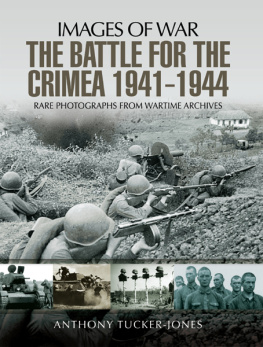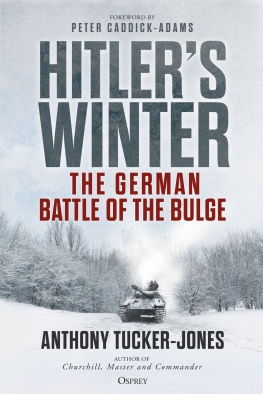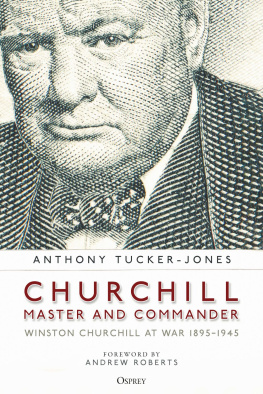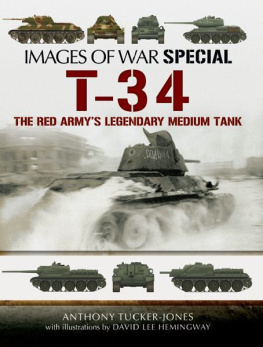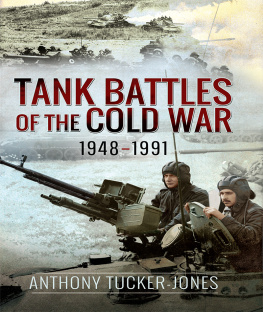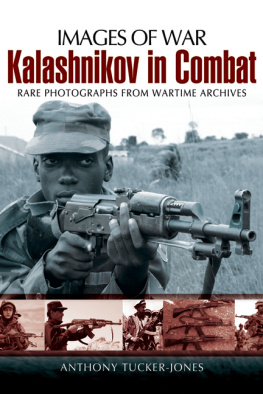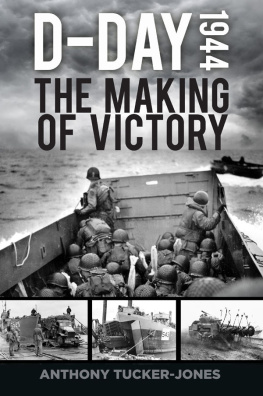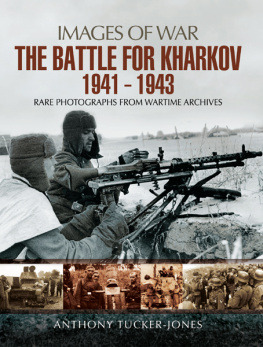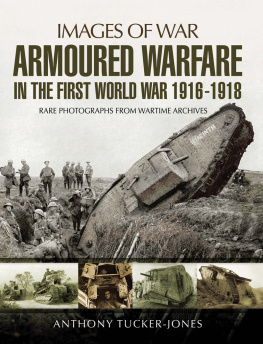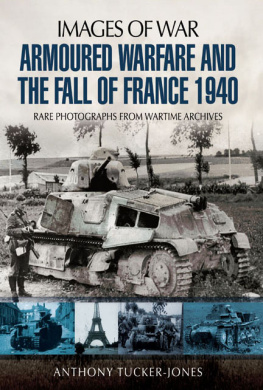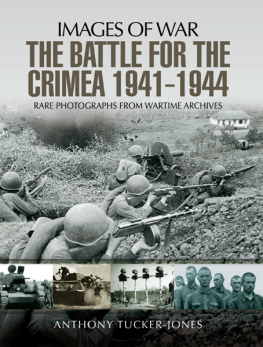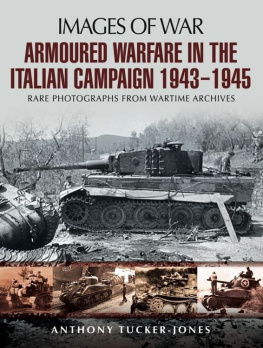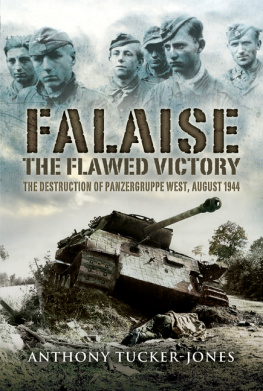Anthony Tucker-Jones - The Battle for the Crimea 1941-1944: Rare Photographs from Wartime Archives
Here you can read online Anthony Tucker-Jones - The Battle for the Crimea 1941-1944: Rare Photographs from Wartime Archives full text of the book (entire story) in english for free. Download pdf and epub, get meaning, cover and reviews about this ebook. year: 2016, publisher: Pen and Sword Military, genre: Non-fiction. Description of the work, (preface) as well as reviews are available. Best literature library LitArk.com created for fans of good reading and offers a wide selection of genres:
Romance novel
Science fiction
Adventure
Detective
Science
History
Home and family
Prose
Art
Politics
Computer
Non-fiction
Religion
Business
Children
Humor
Choose a favorite category and find really read worthwhile books. Enjoy immersion in the world of imagination, feel the emotions of the characters or learn something new for yourself, make an fascinating discovery.
- Book:The Battle for the Crimea 1941-1944: Rare Photographs from Wartime Archives
- Author:
- Publisher:Pen and Sword Military
- Genre:
- Year:2016
- Rating:3 / 5
- Favourites:Add to favourites
- Your mark:
- 60
- 1
- 2
- 3
- 4
- 5
The Battle for the Crimea 1941-1944: Rare Photographs from Wartime Archives: summary, description and annotation
We offer to read an annotation, description, summary or preface (depends on what the author of the book "The Battle for the Crimea 1941-1944: Rare Photographs from Wartime Archives" wrote himself). If you haven't found the necessary information about the book — write in the comments, we will try to find it.
Anthony Tucker-Jones: author's other books
Who wrote The Battle for the Crimea 1941-1944: Rare Photographs from Wartime Archives? Find out the surname, the name of the author of the book and a list of all author's works by series.
The Battle for the Crimea 1941-1944: Rare Photographs from Wartime Archives — read online for free the complete book (whole text) full work
Below is the text of the book, divided by pages. System saving the place of the last page read, allows you to conveniently read the book "The Battle for the Crimea 1941-1944: Rare Photographs from Wartime Archives" online for free, without having to search again every time where you left off. Put a bookmark, and you can go to the page where you finished reading at any time.
Font size:
Interval:
Bookmark:


Considered a military backwater, the bulk of the Red Armys tanks in the Crimea consisted of old T-26, such as the one seen here, and BT-5 tanks. Both had come into service in the early 1930s.
First published in Great Britain in 2016 by
PEN & SWORD MILITARY
an imprint of
Pen & Sword Books Ltd,
47 Church Street,
Barnsley,
South Yorkshire
S70 2AS
Text copyright Anthony Tucker-Jones, 2016
Photographs copyright as credited, 2016
Every effort has been made to trace the copyright of all the photographs. If there are unintentional omissions, please contact the publisher in writing, who will correct all subsequent editions.
A CIP record for this book is available from the British Library.
ISBN: 978 1 47386 730 7
PDF ISBN: 978 1 47386 733 8
EPUB ISBN: 978 1 47386 732 1
PRC ISBN: 978 1 47386 731 4
The right of Anthony Tucker-Jones to be identified as Author of this Work has been asserted by him in accordance with the Copyright, Designs and Patents Act 1988.
All rights reserved. No part of this book may be reproduced or transmitted in any form or by any means, electronic or mechanical including photocopying, recording or by any information storage and retrieval system, without permission from the Publisher in writing.
Typeset by CHIC GRAPHICS
Printed and bound by CPI Group (UK) Ltd, Croydon, CR0 4YY
Pen & Sword Books Ltd incorporates the imprints of Pen & Sword Archaeology, Atlas, Aviation, Battleground, Discovery, Family History, History, Maritime, Military, Naval, Politics, Railways, Select, Social History, Transport, True Crime, Claymore Press, Frontline Books, Leo Cooper, Praetorian Press, Remember When, Seaforth Publishing and Wharncliffe.
For a complete list of Pen & Sword titles please contact
Pen & Sword Books Limited
47 Church Street, Barnsley, South Yorkshire, S70 2AS, England
E-mail:
Website: www.pen-and-sword.co.uk
Contents
Introduction
W hen Adolf Hitler invaded the Soviet Union his armies charged into Byelorussia through the cities of Minsk and Smolensk toward Moscow. In the north they swept through the tiny Baltic States to the very gates of Leningrad. In Ukraine Hitlers forces stormed into Kiev and Kharkov. In the very far south German troops and their Romanian allies fought their way to the Black Sea port of Odessa and thrust into the Crimea.
Of all the battles fought on the Eastern Front, the battle for the Crimea was one of the most desperate. Thanks to the Crimeas geography it was very difficult for both sides to feed in reinforcements and supplies to the battlefield. In a series of operations the Germans subdued Soviet resistance despite the Red Armys heroic efforts to hold the naval base of Sevastopol. It took the Axis forces ten long months to conquer the Crimea in 1941-42. In particular the Soviet defenders of Sevastopol held out for 250 days.
The German high command considered the campaigns in the Crimea as a sideshow, much as they did with North Africa. They felt it to be largely irrelevant in the greater scheme of things. Operation Orkan (Hurricane) was designed to take the great fortress of Sevastopol from the Red Army. This was the responsibility of Field Marshal Fedor von Bocks Army Group South as a preliminary to Operation Blau which was to be launched along the length of the Eastern Front in the summer of 1942.
Clearing the Soviets from the Crimea was a necessity to protect Army Group Souths right flank. It would also facilitate the German 11th Army crossing from the Crimea into the Taman Peninsula to support 1st Panzer Army and 17th Army in their offensive along the eastern coast of the Black Sea after sweeping across the lower reaches of the Rivers Don and Donets.
Field Marshal Erich von Manstein, who commanded the German forces in Crimea, was fulsome in his praise of their fighting abilities:
In attack and pursuit their aggressive spirit was unparalleled; and when the situation appeared hopeless they would stand and fight unflinchingly. Often they may have not known what compelled us to make demands on them that seemed impossible to fulfil, or why they were flung from one action to another and from one front to the next. And yet they went to the very limit of endurance to carry out these demands, reciprocating the trust of those who led them.
What made the fighting in Crimea so remarkable was that it was one of the few instances where a German army fought a battle without any real interference from Hitler. Thanks to its isolated geography the Axis forces committed to the battle for the Crimea in 1941 were able to operate independently. As Manstein recalled:
It was a campaign which, in ten months of incessant fighting, included both offensive and defensive battles, mobile warfare with full freedom of action, a headlong pursuit operation, landings by an enemy in control of the sea, partisan engagements and an assault on a powerfully defended fortress.
The Crimean land mass is almost an island, attached to the mainland by two narrow land bridges to the north and one to the east. As the war progressed, Axis forces stationed in Russia and Ukraine going home on leave or being medically evacuated had to travel huge distances by road or rail. In Crimea the easiest way out was across the Black Sea to Odessa in the Ukraine or Constanta in Romania, but that meant running the gauntlet of the Soviet Navy.
When the Red Army launched a series of counteroffensives in late 1943, Axis forces were cut off in the Crimea. Hitler stuck to his normal ridiculous dictat that no ground must be relinquished and that the garrison should stay put until relieved. In 1944 the Red Army liberated the Crimea and Sevastopol in the space of just four days. The German and Romanian units were left to face a terrible fate, culminating in an Axis version of Dunkirk with an evacuation fleet sailing for the Romanian port of Constanta. The Soviet air forces and navy contested their passage with bloody results. Only the bravery of the Romanian Royal Navy ensured that tens of thousands of Axis troops were rescued from the Khersones Peninsula.
For those German, Romanian and Soviet soldiers who survived the terrible battles fought in the Crimea, the killing grounds of the Perekop Isthmus, Sivash Sea and the Kerch Straits were forever burned into their memories.
Photograph Sources
A ll the images in this book are courtesy of the Scott Pick WWII Russian Front Original Photo Collection. This consists of almost 2,500 black and white photographs. They provide a remarkable and often grim insight into the many aspects of the war on the Eastern Front. Notably, the quality of the photographs is consistently high throughout the archive. Most of those selected by the author to illustrate this title have never been published before. Pen & Sword and the author are indebted to Scott Pick for his generous assistance with this project.
Chapter One
The Road to Sevastopol
I n the wake of Hitlers invasion of the Soviet Union the Romanian 4th Army moved over the Dniester River on 3 August 1941, with the intention of occupying the Ukrainian Black Sea port of Odessa. The Romanians were given this task on the assumption that the Soviet garrison, known as the Separate Coastal Army, would quickly surrender once hemmed in. Things did not go according to plan and the fierce Soviet resistance did not bode well for the capture of Sevastopol in the Crimea.
Although the Romanian Air Force fought well against the Red Army and Red Air Force, crucially it was unable to prevent the Soviet Black Sea Fleet from supporting Odessa. In addition the small Romanian Navy was outnumbered and outclassed by the much bigger Soviet fleet. This meant that it was held back to protect the shipping routes in and out of the Romanian port of Constanta and through the Bosporus into the Mediterranean. Nonetheless, two Romanian torpedo boats managed to intercept a Soviet destroyer south of Odessa on the night of 18 August 1941 and damaged it.
Next pageFont size:
Interval:
Bookmark:
Similar books «The Battle for the Crimea 1941-1944: Rare Photographs from Wartime Archives»
Look at similar books to The Battle for the Crimea 1941-1944: Rare Photographs from Wartime Archives. We have selected literature similar in name and meaning in the hope of providing readers with more options to find new, interesting, not yet read works.
Discussion, reviews of the book The Battle for the Crimea 1941-1944: Rare Photographs from Wartime Archives and just readers' own opinions. Leave your comments, write what you think about the work, its meaning or the main characters. Specify what exactly you liked and what you didn't like, and why you think so.

